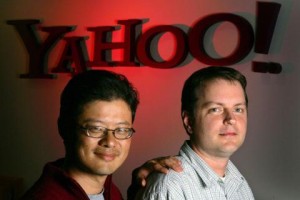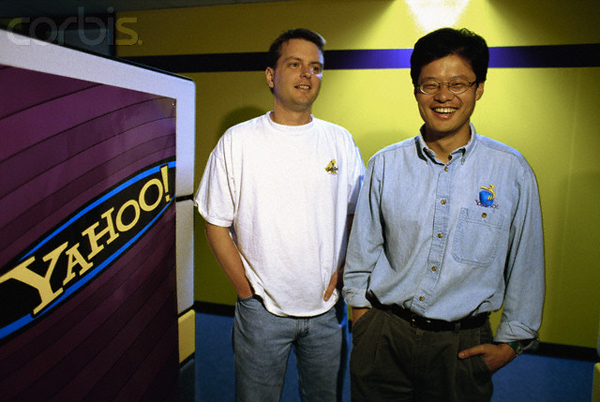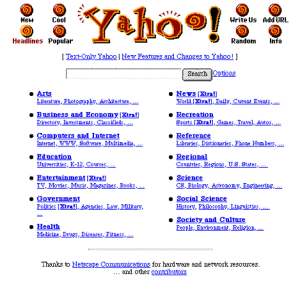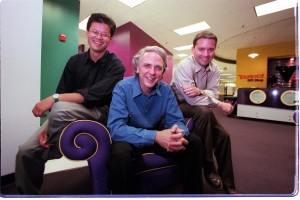Yahoo was officially incorporated on March 2nd, 1995. This is a partial transcript of several episodes of the Internet History Podcast, including an oral history interview with Tim Brady, Yahoo’s employee number 3. You can listen to the full episodes at the bottom of this article.
In the beginning, there was Jerry and David’s Guide to the World Wide Web…
In early 1994, Jerry Yang and David Filo were PhD students in electrical engineering at Stanford. Yang was the outgoing, gregarious one of the two. Born in Taiwan, Yang moved with his family to California when he was ten. He claims that on his first day of school in America, the sum total of his English vocabulary was the word “shoe.” Filo was the quieter, more circumspect of the pair— so circumspect, in fact, that friends nicknamed him The Unabomber. Filo was born in Wisconsin, but was largely brought up in Louisiana. The two knew each other from their time at Stanford, but really bonded when they signed up for a brief teaching stint in Japan. The dissertation that the two were (ostensibly) working on in the Spring of 1994 involved design automation software, which was a hot area of research at the time. Yang and Filo shared side-by-side cubicles in a Stanford portable trailer, in lieu of official offices. They had the place to themselves. Their dissertation advisor was on sabbatical so they were free to order pizza, goof around, and oh yeah, occasionally research. They named their computer workstations after their favorite sumo wrestlers, a passion they had picked up during their time in Japan (Yang’s was named Akebono; Filo’s was named Konishiki). More often then not, one or both of them would end up sleeping in the trailer. A friend called the trailer “a cockroach’s picture of Christmas.”
But the two students weren’t exactly burning through their dissertation. Filo had discovered the Mosaic browser shortly after it was released, and this led the pair to an all-consuming obsession with the World Wide Web. In those days, it was still possible to visit every single website in existence in a matter of a few hours. But new websites were popping up every day. So, in the hours when they should have been doing research, they were browsing the web instead, trying to find and catalog the new. Always a bit intellectually competitive, the two began collecting and trading links to the new websites they found. They started compiling these favorite links into a list, each trying to outdo the other by finding the coolest new site of the day. “I kept bugging Dave to show me the sites he had found,” Yang remembered later. “So he made his hot-list, and I made my hot-list, and he wrote some software to combine both our lists.”
This was right at the moment when Mosaic was lighting the fuse under the powder keg that was the early web. As the web grew that summer, things got a bit more complicated. Because Yang’s workstation was hooked up to Stanford’s public Internet connection, other people could view the list the two were generating by going to http://akebono.stanford.edu. The list was called Jerry’s Guide to the World Wide Web (initially, Filo didn’t want his name attached) and it proved popular among Yang and Filo’s group of friends. Word of mouth spread news of the list even further and soon complete strangers were emailing in suggestions of new sites to be included. In order to keep things reasonably organized, Yang and Filo broke the list out into a hierarchical directory. Thus, to find MTV’s home page, a user drilled down by category: Entertainment > Music > Music Videos > MTV.com. The pair came up with their own software to seek out ever-newer sites and webpages, but the additions to the directory were made entirely at Yang and Filo’s discretion. In those days, there was no automation or algorithm.
The pair began working on the directory to the exclusion of almost everything else. It was an all-consuming project, an obsession. They would toil away on Yahoo for dozens of hours at a stretch, trading off sleeping on the floor, only to go back to more searching and more indexing. For Yang and Filo, it wasn’t work; it was fun. The added benefit was, it wasn’t what they were supposed to be doing. “We wanted to avoid doing our dissertations,” Yang admitted. Yahoo was the perfect distraction. When their dissertation advisor returned from her European sabbatical, she was stunned to find that the messy trailer was the headquarters of a world famous Internet phenomenon.
 By September 1994, Yang and Filo had compiled a directory of more than 2,000 sites. What was more impressive was the fact that Jerry’s Guide to the World Wide Web was getting 50,000 hits (searches) a day. The same parabolic web growth that Mosaic had simultaneously ridden and helped stoke was buoying Jerry’s Guide as well. What had started as a hobby now became a full time project. “We were in a unique situation in the summer of 1994,” Yang remembered later, “to be able to experience that kind of grass-roots growth, fueled by a lot of interest that was not our doing, and then just sitting back to watch the access logs go up.” The pair decided that their project needed a better name. A convention among software developers at the time was to name projects “Yet Another Something Something.” For example, YAML was Yet Another Markup Language. So, Yang and Filo settled on the name Yahoo!, which they claimed stood for Yet Another Hierarchical, Officious Oracle. The exclamation point was irreverent and entirely intentional—as Filo put it, “Pure marketing hype.” The url became http://akebono.stanford.edu/yahoo.
By September 1994, Yang and Filo had compiled a directory of more than 2,000 sites. What was more impressive was the fact that Jerry’s Guide to the World Wide Web was getting 50,000 hits (searches) a day. The same parabolic web growth that Mosaic had simultaneously ridden and helped stoke was buoying Jerry’s Guide as well. What had started as a hobby now became a full time project. “We were in a unique situation in the summer of 1994,” Yang remembered later, “to be able to experience that kind of grass-roots growth, fueled by a lot of interest that was not our doing, and then just sitting back to watch the access logs go up.” The pair decided that their project needed a better name. A convention among software developers at the time was to name projects “Yet Another Something Something.” For example, YAML was Yet Another Markup Language. So, Yang and Filo settled on the name Yahoo!, which they claimed stood for Yet Another Hierarchical, Officious Oracle. The exclamation point was irreverent and entirely intentional—as Filo put it, “Pure marketing hype.” The url became http://akebono.stanford.edu/yahoo.
Stanford had a long history of being supportive toward student-run projects that may or may not evolve into startups at some later date. So, at least initially, Stanford was a generous host of Yahoo’s traffic and content, free of charge. When Netscape launched its beta browser late in 1994, it decided to make Yahoo the default link when a user clicked the “Directory” button on the top menu of the browser. No one could have anticipated it beforehand, but it turned out that having a button in Navigator’s menu bar was almost as valuable as having an icon on the Windows desktop. All those early web users who surfed the web via Netscape were introduced to Yahoo as the defacto search utility. The flow of curious web searchers grew into a flood. Yahoo had its first million hit day late in 1994. By January of 1995, soon after the domain Yahoo.com was registered, Yahoo had grown into a directory of 10,000 sites and was getting more than 100,000 unique visitors a day. The servers began to struggle under the deluge. And it turned out that there was a limit to Stanford’s generosity. The university asked Yang and Filo to find another host for their website.
Marc Andreessen and Mike Moritz to the rescue
For Yang and Filo, it was the moment of truth. For months, they had left their dissertation languishing. Now it was time to decide if Yahoo was a real thing or not, and whether or not the boys were willing to become businessmen. “David had it in his gut very early on that Yahoo could ultimately be a consumer interface to the Web rather than simply a search engine or a piece of Technology,” Yang told Fortune magazine. “We weren’t really sure you could make a business out of it though.” Interested parties were already forming a line at Yahoo’s trailer door. Reuters, MCI, Microsoft, CNET and a pre-IPO Netscape all met with the boys to see if some form of partnership or buyout was possible. In order to build bridges, Marc Andreessen reached out and solved the hosting problem by agreeing to host Yahoo temporarily on one of Netscape’s spare Silicon Graphics servers. Yang and Filo would be able to leave Stanford behind and strike off on their own. They took the leap into entrepreneurship.
The Venture Capitalists came calling as well, and now the boys were ready to talk seriously to them. But the moneymen were a bit skeptical about whether or not Yahoo even was a business. Netscape might have seemed like a dubious proposition when it was looking to raise funds around the same time: barely making money, kinda-sorta giving away their product for free, unproven market, etc. But at least Navigator was a software package. People understood that software could be sold. And Netscape was proving it could make real money providing support and server packages to supplement their software. Yahoo, on the other hand, wasn’t exactly software. It was a service; a destination; a directory; a glorified list. There was almost nothing proprietary about it. Anyone could make a list of websites. Furthermore, it was a service that you could never charge for. Yang and Filo were convinced—quite rightly—that the day they started charging users to search would be the last day users ever visited Yahoo’s website ever again. If Netscape’s business seemed intangible, Yahoo’s seemed downright hypothetical.
Undeterred, Yang and Filo incorporated Yahoo on March 2, 1995, and Yang began circulating a scratched-together business plan, but failed to impress the VC’s who were sniffing around. Even a March 1995 feature story in Newsweek didn’t overcome the skepticism. Among others, Kleiner Perkins took a pass, despite the close ties Yahoo had to its big Internet investment, Netscape. But one of those who made the trek to the messy Stanford trailer (before Yang and Filo vacated it for a proper office) was a VC named Mike Moritz. Moritz described the squalor in the trailer as, “…every mother’s idea of the bedroom that she wished her sons never had.” Moritz and his team quizzed Yang and Filo among the empty pizza boxes and humming workstations, asking the obvious question: “So, how much are you going to charge subscribers?”
“Dave and I looked at each other and said, ‘Well, it’s going to be a long conversation,” Yang would recall. The pair intended to stick to their guns. There would be no fees to users. “Two hours later, we convinced them that Yahoo should be free.” Moritz was a young 40-year-old General Partner at the VC firm Sequoia Capital. Sequoia had funded such Silicon Valley luminaries as Apple, Atari, Cisco and Oracle, but it had not yet dipped its toe into Internet waters. When Moritz took Yahoo’s business plan back to his firm, he encountered the same skepticism from the other partners that Yang and Filo had run into at every other VC firm in town. The product was free! Yang and Filo had absolutely zero business background or acumen! What was to stop someone else (Microsoft? AOL?) from simply making their own directory? And then there was that crazy name. The very moniker “Yahoo” was enough to make some of the other partners at Sequoia dubious, sight unseen. The vision that Moritz used to argue Yahoo’s case was the one put to him by Yang and Filo. Yahoo already had millions of loyal users; surely there would be some way to monetize them. As more and more users were coming to the web, Yahoo could be the friendly guide that would hold the hands of new users and lead them out into the void.
If there was an elevator pitch, it was that Yahoo had the chance to be the TV Guide for the Internet. Like Yahoo, TV Guide simply provided information that any other entity could aggregate. And yet, TV Guide was the largest circulation magazine on the planet. There was value in being the trusted directory for something. Sequoia eventually bought the pitch. The factor that tipped the scales in Yahoo’s favor was the fact that Moritz was pitching a revenue model the other Sequoia partners knew very well: advertising-supported mass media. Radio was free. Television was free. Both were supported by advertisers who paid good money to reach an audience of millions. “So why will the Internet be any different?” Moritz asked. “The trick, strategically, was to get an audience and at some point the advertisers would come.” Yahoo had an audience of millions, and if the Web kept growing at the rate it was growing at, who knew how many hundreds of millions could be reached in the near future?
By that logic, even the wacky company name could be seen as a plus rather than a minus. If done the right way, Yahoo could create a brand that would be fun, funny, irreverent, hip—in short, perfectly suited for the burgeoning Internet audience. And after all, as Don Valentine, the legendary founder of Sequoia put it, “A long time ago, we helped finance a company called Apple.”
That investment had turned out handsomely.
Building a “real” (web) business
In April of 1995, Sequoia invested $1 million dollars in exchange for 1/4th of the newly incorporated Yahoo. This investment would turn out handsomely as well. By early 1999, Sequoia’s initial $1 million was worth $8 billion. At the peak of Yahoo’s market valuation, the value of that initial 1/4th of Yahoo would be worth more than $30 billion. With its first infusion of cash, Yahoo went about becoming the business Yang and Filo had thrown academia over for. 1,500 square feet of office space was secured at the auspicious address of 110 Pioneer Way in Mountain View. Engineers were brought onboard to help Filo setup Yahoo’s servers and technologies in-house. Finance folk were brought on to structure Yahoo like a mean, lean startup. An “adult” was brought in to be CEO, in the person of Tim Koogle, a veteran of both tech startups and the tech establishment (he was recruited from Motorola and like Yang and Filo, Koogle was a veteran of the Stanford Engineering department). As for the two boys, Yang took the official title of “Chief Yahoo,” and continued to be the face of the company. Filo took the title of “Cheap Yahoo,” and dedicated himself to keeping the tech side running smoothly.
Most importantly, a cadre of new hires was fashioned into a team of professional web surfers who would help build out the Yahoo directory and stay on top of the exploding web. The surfers, who would eventually number more than 50, were expected to each add as many as a thousand new sites a day to the directory. They were overseen by a longtime friend of Yang and Filo’s, Srinija Srinivasan, who became the “Chief Ontologist,” the head of the Yahoo directory efforts. And this is a key thing to keep in mind: Yahoo! was a human powered directory for the web, not a “search engine.” Yahoo did farm out search functionality to various partners, but the key selling point—at least, for much of its early life—was that it was human powered and human curated. This was in stark opposition to competitors at the time like Excite, AltaVista, Lycos and others.
Despite this focus on a human face behind the exploding web, Yahoo adopted the Netscape “get big fast” strategy. This was partly because it had to. The web was growing exponentially, and all those humans at Yahoo needed to keep up with it. There was also the matter of competition. One by one, the other search sites had all taken various forms of venture investment and were eager to prove that algorithmic search engines were superior Internet guides. Then there was the little matter of Yahoo’s easily replicated directory. If an established player copied Yahoo’s glorified list, what could prevent Yahoo being steamrolled? “It wasn’t rocket science,” Filo admitted. “We didn’t have patents or anything like that. Someone smart with resources could have done the same thing.”
It was a threat Yahoo knew all too well. Back when Yang and Filo had been shopping the company to investors, America Online had made a $2 million dollar buyout offer. The offer was a bit lowball, and to hear Yang tell the story, it wasn’t exactly friendly. “They tried to buy us, and we said no, and they said, ‘We’ll crush you in two months.’” AOL was saying point blank that it could and would build it’s own directory. It seemed that Steve Case had learned some negotiation tactics from his run-ins with Bill Gates. Yahoo was bold enough to spurn AOL and go off on it’s own because Yang was confident that his directory had a unique relationship with it’s users. The main strength that Yahoo felt it had was, quite simply, it had been first. It would become an article of faith during the dot com era that being first to market on the Internet frontier conferred a magical “first mover advantage,” on whomever was so fortunate to have been the pioneer. Certainly, Yahoo’s experience did nothing to disprove this. Those early months as the default search tool on Navigator had sown the seeds of familiarity and loyalty among early Internet adopters. Once they learned about Yahoo, they came back again and again, almost automatically. Even when competing services showed up on the prairie, users had a tendency to stick with what they knew, so long as it still worked. The first mover advantage meant that Yahoo had a big head start in the land grab for market and mindshare among early web devotees. This was a lead that was Yahoo’s to lose.
Branding, and the IPO
In order to stay ahead, Yahoo decided it would do what no one else had (intentionally) done on the web up to that point: brand itself, in order to reinforce its users’ loyalty. As early as June of 1995, Jerry Yang declared that Yahoo would become, “The first great Internet brand.” With millions of users already familiar with Yahoo and tens of millions of “newbies” on their way, becoming the first Internet brand would be invaluable. The thinking was, “If you’re a brand name that people know, [your site] is where they’re going to go first.” The woman quoted above was Karen Edwards, another early hire who was brought on to direct Yahoo’s marketing efforts. With previous experience at Clorox and 20th Century-Fox, Edwards would help Yahoo do something that was completely radical for the time: advertise on TV and radio. Yahoo was debatably the first Internet company to do so. With zippy, hip ads, matching the slick name and the brash image of the site overall, Americans found themselves being asked “Do You Yahoo?” Yahoo quickly became one of the Internet’s most recognizable names, familiar even to the vast unwashed Americans who were not yet even online.
With its quirky purple logo Yahoo was soon everywhere, from hockey rinks to billboards to t-shirts. BusinessWeek said that Yahoo projected a “cool California image—hip but not rad, easy-to-use but not simplistic.” By 1998, this hip but not rad service was better known to the average consumer than direct competitors like Excite or Lycos, and even better known than behemoths like Microsoft. The branding was instrumental in helping Yahoo stand out from the scrum of the search engine pack. But it also played a vital role in turning what was an unpatentable service (a directory) into a valued, strategically defensible product.
Yahoo was smart in turning its lack of technological uniqueness into a strength. From the very beginning, Yahoo denied it was even a technology company. “The fundamental bet we are making is that we are a media company, not a tools company,” Yang told Fortune magazine. “If we are a tools company, we are not going to survive. Microsoft will just take over our space. If we are a publication, like a FORTUNE or a Time, and we create brand loyalty, then we have a sustainable business.” Making Yahoo the first great brand of the Internet era would serve Yahoo well throughout the entire dot com era. When later asked why Yahoo enjoyed a greater stock market valuation than rivals such as Excite, a stock analyst would reply, “Yahoo is cool! It’s not a technology company. It’s a brand, it’s an article of culture.”
The branding and the advertising efforts were paid for by additional rounds of venture capital investment. In November of 1995, Reuters, Ziff Davis, and the Japanese firm Softbank kicked in a new $5 million dollars. Yahoo was able to command a $40 million dollar valuation, quite impressive considering it had valued itself at only $4 million eight months earlier. Even that would look like chump change a few months after that when Softbank doubled down by investing an additional $100 million all on it’s own.
Investors were falling over each other to hand Yahoo money for two reasons. For one, the Big Bang had gone off in September of 1995: Netscape had gone public. The Internet was hot. Wall Street was in search of net companies that seemed to have the same growth trajectory as Netscape. Search engines had the largest audience of netheads anywhere, and Yahoo was leading the pack. By February of 1996, the site was seeing more than 6 million visitors every single day. Those traffic numbers were double what Yahoo had seen just 5 months before. The growth was parabolic. Now that Wall Street was living in a post-Netscape world, the pressure built for Yahoo to go public as well. The company actually didn’t need to; the second Softbank investment had left it with quite the war chest. But Excite, Lycos and InfoSeek were all filing to go public and profit by lining up in Netscape’s slipstream. Yahoo couldn’t turn down the opportunity to raise even more money and maintain its lead against its search engine rivals.
Plus, Netscape had shown that there was an incredible amount of free publicity to be gained by a successful, high-profile IPO. By sitting out the party, Yahoo risked ceding its role as the industry leader, at least in the eyes of Wall Street. Excite and Lycos enjoyed moderately successful IPOs in early April of 1996 (InfoSeek went public a few months later). Yahoo went public on April 12th, selling 2.6 million shares, initially pricing at $13, but seeing a first trade price of $24.50. Over the course of the first day, the stock peaked at $43 before ending the day at $33. This 154% leap over the offer price was better than even Netscape’s 105% first day pop. More importantly, this made Yahoo’s market value $850 million, which was more than Excite’s $206 million and Lycos’ $241 million, respectively.
Time to, you know, actually make some money
As planned, Yahoo held on to the search industry crown; all the other engines would look like pretenders to the throne. Yahoo now had hundreds of millions of dollars in the bank. Yang and Filo had each pocketed about $130 million on paper. But Yang said that the IPO had merely induced “panic—no, not panic, but anxiety.” That was because there was one looming problem: for all the dollar signs in Yahoo’s bank account, there wasn’t actually much on Yahoo’s bottom line. In its first quarter as a public company, Netscape had recorded revenue of $56.1 million. In its first quarter as a public company, Yahoo could only report revenue of $3.2 million. Even that was better than 1995, when Yahoo reported revenue of only $1.4 million… for the entire year. Again, if Netscape had gone public with questionable revenues, Yahoo had taken things to the next (lower?) level. But investors had shown that they were willing to invest in unprofitable young web companies so long as they could show revenue growth. So, Yahoo would be ok, as long as it could show continued audience growth… but only if it could find a way to pivot monetize that audience. One day. Preferably soon.
No problem, right? Remember, Yang had sold Sequoia on the company’s prospects by promising to becoming an advertising supported media company. One big issue: the Internet had been born free of advertising and free of commerce of any kind. Internet culture had an emphasis on “free” and had a downright hostility to advertising especially. But now that the Internet was in the midst of a gold rush, the pressure to make cyberspace pay was overwhelming. Advertising was the obvious business model for any website that wanted to remain free for it’s users.
At the time, Yahoo liked to give the impression that it came to the advertising model reluctantly, but really, there was no other feasible option. Yahoo’s original business plan called for limited advertising as a way to monetize Yahoo’s growing traffic. As early as April 1995, soon after the original Sequoia investment, David Filo granted an interview to Advertising Age magazine. Under the headline, A Gaggle of Web Guides Vies For Ads Yahoo Directory Opens To Sponsorship Deals As Competition Grows, Filo declared, “Because we are now backed by a third party, there’s pressure to produce. Yahoo will have to become a money-making enterprise. We’re not sure if we want to start reviewing sites or continue to just list sites in a comprehensive fashion, but we are definitely going to integrate advertising into what we do.”
Still, Yahoo treaded lightly. Yang and Filo didn’t want ads to interrupt their directory, but ads around the directory might be ok. The company put a survey on its home page asking users whether they would countenance ads. The response was lukewarm acceptance. When ads first launched in August of 1995, there were the inevitable howls from some users that Yahoo was selling out, but the protests quieted down after only a few weeks. The directory hadn’t changed. It was just as useful as it always was. The users stayed loyal. Just as Yahoo was a pioneer in bringing notions of branding and audience loyalty to the web, the company was also a pioneer in the way that it gambled with advertising as a business model on the Internet. Thousands of websites and companies that would be founded in the coming years would follow Yahoo’s example and use advertising to subsidize their “real” product.
The pivot toward advertising was quickly very lucrative for Yahoo. Once the company turned on the advertising spigot, it ramped things up rapidly, signing on more than 80 sponsors in less than 6 months. The advertisers and the advertisements would only increase with Yahoo’s growing traffic numbers. By the fourth quarter of 1996, the website could boast 550 advertisers, including many Fortune 500 companies such as Wal-Mart and Coca-Cola. This all lead to an impressive 1,300 percent increase in its revenues, to $19.7 million in 1996. Being the Internet’s best-known destination allowed Yahoo to command very rich CPM rates in the $20-$25 range. And since Yahoo’s traffic continued to grow so rapidly, the company found it literally could not sell ads fast enough. By 1996, as page views reached 14 million a day, as much as 75% of Yahoo’s potential ad space went unsold. There was simply too much traffic to sell.
King of the dot-com era
Yahoo seemed to go from strength to strength. Because the site had so successfully branded itself as the Internet’s version of the Yellow Pages, countless brands and retailers jockeyed to purchase valuable real estate on Yahoo’s pages. As the dot com era got into full swing, Yahoo found that new dot com companies would compete viciously among themselves for prominent placement. Amazon.com and CDNow.com could be played off one another to advertise music sales. E*Trade and Datek Online would sign multimillion dollar deals just to put online trading buttons on Yahoo. And it wasn’t just retailers; when Yahoo decided to add news, weather, stock prices and other curios to it’s directory, it found that media partners such a Reuters were eager to partner and provide content in exchange for a share of the advertising revenues. “There was a land grab,” a Yahoo marketing executive would remember. “It was no one’s fault, but lots of companies were overinvesting and trying to grow too fast. It’s hard to blame Yahoo for that—but sure, we were right there taking the money.”
By 1997, the online advertising market neared $1 billion, and Yahoo alone was estimated to control 7.5 percent of the total. Yahoo’s advertising base shot to 1,700. These advertisers were chasing traffic that had skyrocketed to an astounding 65 million page views per day. And all of this led to a proportionate 257 percent rise in revenues to $70.4 million. Yahoo’s stock rose accordingly, jumping 511 percent over the course of 1997. The company at that point had a market value of almost $4 billion. The world would come to think of Yahoo as one of the leaders of the new Internet era. Perhaps inevitably, Yahoo began to think of itself differently as well. The company head count quintupled over the course of 1996, and doubled again in 1997, eventually reaching more and 400 people. This explosion of money, people and traffic lead to the commensurate increase in office space, hardware and computing power. When Yahoo moved into a new 12,000 square foot office space before going public, Yang recalled: “We thought, ‘This is great. We’ll never fill this place up.'” In no time they would add so many more offices that the company was spread out over 100,000 square feet of office space.
Yahoo was certainly not short of money to reinvest in its own growth, thanks to the IPO. Foreign versions of Yahoo’s site were launched in Asia and Europe. The easy success Yahoo found in advertising and marketing changed the company’s focus. Yahoo began to see itself not as a technology firm, but as a media firm. The desire for advertising dollars meant that Yahoo was now focusing on users and eyeballs, perhaps losing track of its original goal of cataloging the web. When the site was a simple directory of cool websites, Yahoo had been happy to send users off its pages and out into the farthest reaches of the web. But now that advertising was king, the company began to think of ways to keep users engaged on its own pages, consuming its own content, so that it could serve more of those lucrative advertisements.
Yahoo wanted to be the first site users browsed to when they logged onto the web, the last site users checked at the end of the day, and hopefully a site that users would return to countless times over the course of the day. To this end, Yahoo began to build out more and more related and (hopefully) complementary services: news, horoscopes, sports scores, local community sites. All of this was in the service of generating a platform for more and more targeted advertising opportunities. “We began with simple searching,” Yang told Time magazine, beginning to sound a bit like a studio mogul, “and that’s still a big hit—our Seinfeld if you will—but we’ve also tried to develop a must-see-TV lineup: Yahoo Finance, Yahoo Chat, Yahoo Mail. We think of ourselves as a media network these days.” A Wall Street analyst told BusinessWeek, “You have to look at it [Yahoo] as the new media company of the 21st century.”
Yahoo was certainly not alone in this philosophical shift. By 1997-1998, there was a new watchword: portal. Excite, AltaVista, Lycos, et al—all of the search engines pivoted to become portals to the web. The “portal wars” led to an arms race among all the relevant players that did a lot to accelerate the entrepreneurial and acquisition mania that was the fuel of the bubble-era fire. If one portal added a new feature, say, instant messaging, then all of the portals had to have their own version of that feature. Flush with ever-increasing stock prices and burgeoning market caps, the portal players went on a mad shopping spree, snapping up startups left and right to add to their arsenals.
Yahoo was not immune to catching the fever and going on a spending spree. Yahoo purchased a company called Four11 for a comparatively cheap $94 million, and turned its service, RocketMail, into Yahoo Mail. As ecommerce was predicted to grow as quickly as online advertising, Yahoo wasted no time experimenting with this market as well, launching Yahoo Shopping. By the holiday season of 1998, Yahoo was host to more than 3,000 different merchants. Yahoo Shipping was made possible via the purchase a small company called Viaweb. Rumor had it that in the case of the all-stock purchase of Viaweb, by the time the deal actually closed, Yahoo’s stock price had appreciated so rapidly that the escrow ended up being worth more than the original deal price. Yahoo snapped up a major competitor (in terms of traffic) when it purchased Geocities for $3.6 billion. And of course, the largest, and purhaps most notorious purchase Yahoo ever made was when it paid $5.7 billion for Broadcast.com, in an effort to create the YouTube of the web 1.0 era.
An entire generation of entrepreneurs were caught up in, and benefited from, this acquisition mania. One of the founders of Viaweb? Paul Graham, of Y Combinator fame. Fred Wilson has said that Geocities was his first “mega deal” that paid off. And of course, the reason Mark Cuban is the billionaire-about-town he is today is because he was the founder of Broadcast.com.
By the time the year 2,000 rolled around, Yahoo could rightly be considered one of the most powerful companies of the dot-com era, behind (arguably) AOL but ahead of (again, arguably) Amazon. Netscape might have been first web company, but it had flamed out spectacularly in only five short years. Like everyone else in the tech world, the bursting of the dot-com bubble would lead to difficult times for Yahoo, but no one could deny that by the time the dot-com era crashed to a close, Yahoo had created the first great web company.
Bonus:
I also interviewed Yahoo’s employee #3, Tim Brady, for an oral history episode. Here are some highlights from that episode:
The time early on when Yahoo thought it might be dead:
Early on, Yahoo got a ton of traffic because it was the default “directory” button on Netscape Navigator, when Navigator was the most popular browser in the world. Eventually, Netscape woke up to the value of this “free” traffic and decided to auction off placement on the button. Rival search site Excite.com won the right to replace Yahoo on the button by bidding $5 million. The question was, would Yahoo’s traffic numbers crater without that prime placement?
“Our business model didn’t allow us to bid what Excite did. The day we came off the button we just sat there looking at the logs going, ‘Ok, do we have a business or not?’ Were we so reliant on Netscape that our traffic was going to die. And it didn’t. In fact, it stayed flat for a few days and then continued to go up. That, in my mind, was the day we knew we had a real business.”
The day they gambled the company on advertising:
The early web had a culture that was very hostile to commerce in general, and advertising in particular. But Yahoo felt that advertising was the only business model that would allow it to operate while still providing a free-to-consumer service. Yahoo was one of the first big sites to make a calculated gamble that users would tolerate ads so long as they didn’t get in the way of the service.
“August 1, 1995, was the first day we put advertising up. Until then, we essentially had no graphics on the site. (…) I remember putting up the site [with advertising] and Donald Lobo essentially hitting the return button that put it up, and him just putting his head down on the desk and saying, ‘We just fucking sold out.’ The email box was immediately flooded with people badmouthing us and telling us to take it off. ‘What are you doing? You’re ruining the net.’ (…) It was hard to know if we were doing the right thing at the time. Not that we had, as a business, a whole lot of other options at our disposal.”
Yahoo had always had plenty of search competitors, but they knew Google was an entirely different beast:
“We knew right away we could be in trouble. This was about that time where there was this inflection point in the web… where you expected things to be online. Before, you would be happy if you were looking for something and there was a website about it. And now, at this point, when Google shows up, if you search for 13th century Italian poets, you expected a list of things. (…) When Larry and Sergey showed up and wanted to show us what they did, we knew. We knew it was different. We thought they [the competing search engines] would always be incremental leapfrogs. And this was clear to us that it was different.”
Could Yahoo have done anything to prevent Google from usurping the search crown?
“I ask myself this question every once in a while. I think, in the context of what we did, almost all of the decisions we made were rational. Page Link was something novel. We didn’t think Google could do what they did. And by the time we knew it was going on, it was too late for us to react to it and respond to it in a competitive way. We were also a public company with billions of dollars in revenue, and so, switching course if you will, was pretty hard for us to do. And the other thing was–that isn’t often noted–at the time, Wall Street analysts were pushing on us hard to diversify our offering. So, the idea of doubling down in an area that we were perceived as already kind of dominating–search–would have been not very well received in the investment community. There was some pressure almost not to do it. Looking back on it, I don’t remember a meeting where I can look back and say, ‘Yeah, that’s where we made the mistake.'”
You can listen to that entire episode here:
The original podcast episodes that the above post was transcribed from are here and here. There are plenty more details I left out for brevity in this post.
And of course, there is plenty more Internet history where this came from! Check out our other great interviews here. Chapter episodes are here.
And if you subscribe to the podcast, you can get more great episodes every Monday!


















[…] in 1996, its shares soared by 154% in a single day and in just three years, its founders were worth $8 billion each. The company had a dream run until Google came […]
[…] January 1994, Jerry Yang and David Filo, electrical engineering graduate students at Stanford University created […]
[…] Brian. (2015). On the 20th Anniversary – The History of Yahoo’s Founding. Internet History […]
[…] and organize results. And they were mostly up to the task. At Yahoo!’s peak, surfers were adding a thousand websites a day to the site. Each. Being powered by humans gave Yahoo! an edge. It made them a relatable path of […]